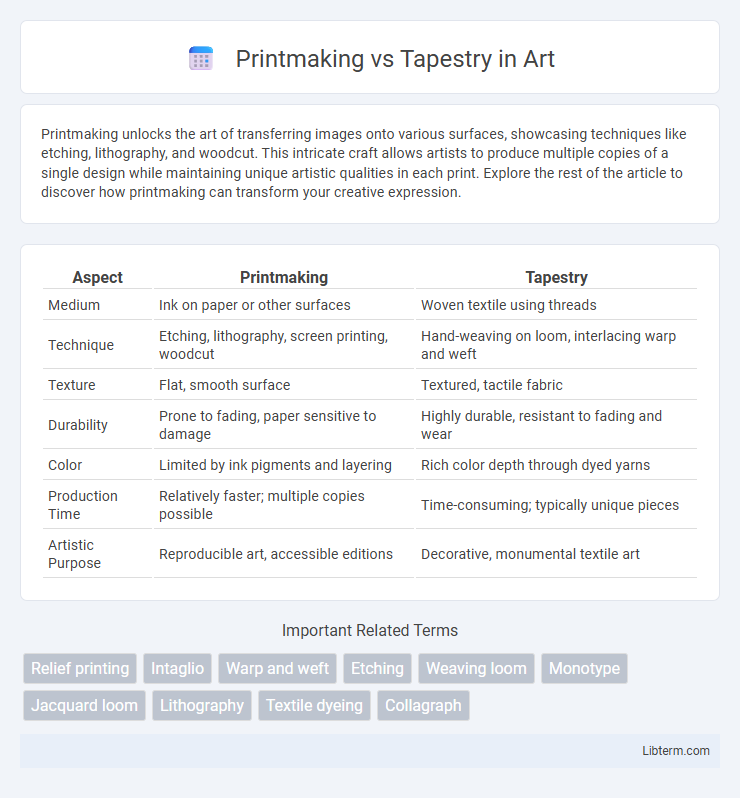Printmaking unlocks the art of transferring images onto various surfaces, showcasing techniques like etching, lithography, and woodcut. This intricate craft allows artists to produce multiple copies of a single design while maintaining unique artistic qualities in each print. Explore the rest of the article to discover how printmaking can transform your creative expression.
Table of Comparison
| Aspect | Printmaking | Tapestry |
|---|---|---|
| Medium | Ink on paper or other surfaces | Woven textile using threads |
| Technique | Etching, lithography, screen printing, woodcut | Hand-weaving on loom, interlacing warp and weft |
| Texture | Flat, smooth surface | Textured, tactile fabric |
| Durability | Prone to fading, paper sensitive to damage | Highly durable, resistant to fading and wear |
| Color | Limited by ink pigments and layering | Rich color depth through dyed yarns |
| Production Time | Relatively faster; multiple copies possible | Time-consuming; typically unique pieces |
| Artistic Purpose | Reproducible art, accessible editions | Decorative, monumental textile art |
Introduction to Printmaking and Tapestry
Printmaking involves creating images by transferring ink from a carved or etched surface onto paper, allowing for multiple reproductions of the same artwork. Tapestry, a form of textile art, is crafted by weaving colored threads on a loom to produce intricate and durable designs, often with rich textures and patterns. Both mediums serve unique artistic purposes: printmaking emphasizes replication and graphic expression, while tapestry focuses on textile craftsmanship and dimensional imagery.
Historical Origins and Evolution
Printmaking originated in ancient China during the Tang Dynasty, evolving through woodblock techniques to more complex methods like etching and lithography by the Renaissance in Europe. Tapestry weaving dates back to the Middle Ages, with significant development in regions like Flanders and France, where it became a symbol of wealth and religious storytelling. Both art forms evolved to reflect cultural and technological changes, with printmaking embracing mass reproduction and tapestry maintaining its handcrafted tradition.
Techniques and Processes Compared
Printmaking involves transferring ink from a matrix such as a metal plate, woodblock, or screen onto paper or fabric through techniques like etching, engraving, lithography, and screenprinting, emphasizing reproducibility and precision. Tapestry weaving requires interlacing warp and weft threads on a loom to create intricate, textured images with rich color gradients, relying on hand craftsmanship and slow, labor-intensive processes. Unlike printmaking's reliance on pressure and ink application, tapestry making focuses on textile manipulation and material layering to produce durable, three-dimensional artworks.
Materials Used in Printmaking vs Tapestry
Printmaking primarily utilizes materials such as woodblocks, metal plates, linoleum, and paper, with inks ranging from oil-based to water-based depending on the technique. Tapestry creation involves textile fibers like wool, silk, and cotton woven on a loom, often incorporating dyed threads to build intricate patterns and imagery. The fundamental difference lies in printmaking's reliance on ink and impression processes versus tapestry's textile construction and weaving methods.
Artistic Styles and Expression
Printmaking offers diverse artistic styles such as etching, screen printing, and lithography, enabling precise detail and reproducible imagery that captures both abstract and realistic expressions. Tapestry emphasizes texture, color blending, and three-dimensional depth through handwoven or machine-made fibers, often conveying rich narratives and cultural symbolism in a tactile form. While printmaking highlights graphic contrast and sharp lines, tapestry excels in creating immersive, layered visual experiences with a focus on materiality and craftsmanship.
Durability and Preservation
Printmaking often produces artworks on paper, which are more susceptible to environmental factors such as humidity, light, and handling, requiring controlled storage to ensure longevity. Tapestries, woven from durable fibers like wool or silk, exhibit greater resilience to wear and aging, often lasting for centuries when properly maintained in stable conditions. Preservation of tapestries involves minimizing exposure to light and pests, while printmaking demands careful archival practices including acid-free materials and climate control.
Cultural Significance and Influence
Printmaking has played a pivotal role in democratizing art by enabling mass reproduction and broad dissemination of cultural narratives, significantly shaping public access to visual storytelling across diverse societies. Tapestry, rooted in ancient textile traditions, serves as a tangible chronicle of historical events and social values, often commissioned by royalty and religious institutions to symbolize power and heritage. Both art forms profoundly influence cultural identity by preserving and propagating collective memory, yet printmaking emphasizes reproducibility and accessibility, while tapestry underscores craftsmanship and symbolic permanence.
Contemporary Applications and Trends
Printmaking in contemporary art emphasizes digital techniques and mixed media to create reproducible, layered imagery that explores themes of identity and social commentary. Tapestry has seen a resurgence through innovative fiber artists who merge traditional weaving with modern designs and sustainable materials, reflecting environmental and cultural narratives. Both mediums intersect in galleries and public installations, highlighting a trend toward blending craftsmanship with conceptual storytelling.
Challenges and Limitations
Printmaking faces challenges such as limited color range and potential degradation of plates after multiple uses, affecting consistency and detail over time. Tapestry production involves labor-intensive weaving processes and high material costs, making mass replication difficult and time-consuming. Both mediums demand specialized skills, with printmaking requiring technical precision for ink application, while tapestry necessitates artisanal expertise in textile manipulation, limiting accessibility for novice artists.
Choosing Between Printmaking and Tapestry
Choosing between printmaking and tapestry depends on the desired texture, durability, and artistic technique. Printmaking offers precise, reproducible images with varied ink effects on paper or fabric, ideal for detailed, graphic-rich artwork, while tapestry provides a tactile, woven texture emphasizing color blending and dimensionality suitable for large-scale decorative pieces. Artists must consider factors like production time, materials, and final display context when selecting the medium that best aligns with their creative vision and functional needs.
Printmaking Infographic

 libterm.com
libterm.com